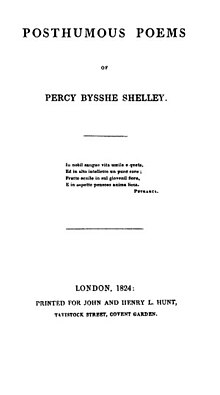
The Triumph of Life was the last major work by Percy Bysshe Shelley before his death in 1822.[1] The work was left unfinished. Shelley wrote the poem at Casa Magni in Lerici, Italy in the early summer of 1822.[1] He modelled the poem, written in terza rima, on Petrarch's Trionfi and Dante's Divine Comedy.[1]
Shelley was working on the poem when he accidentally drowned on 8 July 1822 during a storm on a voyage from Leghorn.[2]
The poem was first published in the collection Posthumous Poems (1824) published in London by John and Henry L. Hunt which was edited by his wife Mary Shelley, who emphasised the importance of the work.
The theme of the poem is an exploration of the nature of being and reality.[1] For Shelley, life itself, the "painted veil" which obscures and disguises the immortal spirit, is a more universal conqueror than love, death, fame, chastity, divinity, or time, and, in a dream vision, he sees this triumphal chariot pass, "on the storm of its own rushing splendour," over the captive multitude of men.[3] Ultimately, natural life corrupts and triumphs over the spirit.[4]
- ^ a b c d Sandy, Mark. "The Triumph of Life". The Literary Encyclopedia. First published 20 September 2002 http://www.litencyc.com/php/sworks.php?rec=true&UID=7981, accessed 25 October 2010.
- ^ Bradley, A. C. "Notes on Shelley's 'Triumph of Life'." The Modern Language Review, Vol. 9, No. 4 (Oct. 1914), pp. 441–456.
- ^ The Cambridge History of English and American Literature in 18 Volumes (1907–21). Volume XII. The Romantic Revival.III. Shelley.§ 9. The Triumph of Life. NY: Putnam, 1907–21.
- ^ Hodgson, John A. "The World's Mysterious Doom: Shelley's The Triumph of Life." ELH, 42 (1975): 595–622.
© MMXXIII Rich X Search. We shall prevail. All rights reserved. Rich X Search
